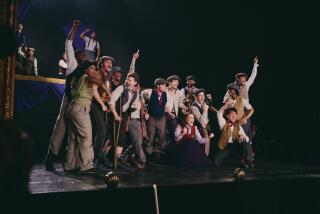FOLLIES’ FINALLY MAKING ITS WAY TO THE TUBE : ‘EVERYONE FELT SENSE OF HISTORY,’ PRODUCER SAYS
- Share via
When a group of Broadway folk got together onstage at Lincoln Center to record the songs of Stephen Sondheim’s “Follies” before a live audience last September, no one anticipated that the house would be sold out within three hours.
But TV producer Ellen Krass-- who specializes in bringing live theater events to the tube (“The Gin Game,” “Sweeney Todd”)--sensed the importance of what was coming. If she hadn’t, we wouldn’t be seeing “Follies” Friday night on PBS. (See adjoining review by Dan Sullivan.)
Pandemonium was one of the words used to describe the event. Perhaps the response came simply from a hunger to experience “Follies” again, a musical ahead of its time.
Perhaps it was a longing to see some familiar and admired faces and hear old voices that had a skimpy chance of being heard in the theater now.
Or perhaps it was a deep reaction of pleasure at seeing something live again in an era where experience is conducted on tape, and tape replay; where art becomes product.
Whatever it was, Krass sniffed it.
“Barbara Ragan, my associate producer, called to say the re-mounting of the cast album was going to take place,” Krass said on the telephone from New York. “I’d always been a gigantic Sondheim fan. I called Herbert Ross, who directed, and told him I wanted to tape it.
“He said no. A week later, he called back to say that he’d become intrigued with the idea. We chatted and chatted, and talked and talked, and finally agreed. But even with everyone’s cooperation, this was not an easy thing to do. There just wasn’t very much money.”
(At first she declined to give figures, but later said the tape had been produced for under $300,000. Her budget for the TV version of “Sweeney Todd” was just under $1 million.)
“The talent onstage worked for scale. But we had the unions to deal with; and the Philharmonic, which only works in two-hour clips, must be paid $11,000 for those two hours. That’s why we decided to take 12 songs and follow them through rehearsal to final performance.”
Did it work? Krass sounded satisfied over the phone.
“I think everybody felt a sense of history. We had four little cameras and an English crew under Michael Houldey’s direction, walking around shouting. No one seemed concerned about the final product. It was as if everyone knew what it would be.
“Elaine Stritch brought the house down. And when Stephen Sondheim walked out onstage at the end, the audience was in an uproar. I’ve been going to the theater since I was 8 years old. I don’t think I’ve ever seen anything like this.”
More to Read
The biggest entertainment stories
Get our big stories about Hollywood, film, television, music, arts, culture and more right in your inbox as soon as they publish.
You may occasionally receive promotional content from the Los Angeles Times.










